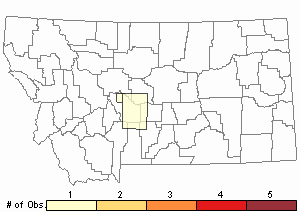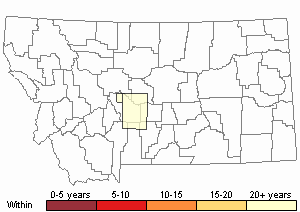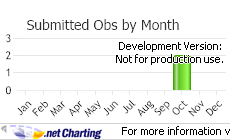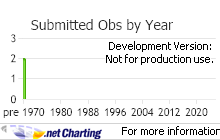View in other NatureServe Network Field Guides
NatureServe
Montana
Utah
Wyoming
Idaho
Wisconsin
British Columbia
South Carolina
Yukon
California
New York
A Tortella Moss - Tortula cernua
Other Names:
Desmatodon cernuus
General Description
Plants: Acrocarpous. Scattered (Lawton 1971) or growing in loose tufts, green to yellow, not shiny. Stems 3-10 mm tall (Crum and Anderson 1981).
Leaves: Upright, a little contorted when dry, (1.5)2-3 mm in length (Crum and Anderson 1981), oblanceolate, spatulate (Lawton 1971), elliptic, the blade forming an apiculus or mucro; apex widely acute, sometimes rounded; margins flat above, curved back along the proximal 1/2 or 2/3, nearly smooth to small-toothed near the bottom of the acumen; border in the lower 2/3 (sometimes almost reaching the apex) consisting of yellowish, narrow, somewhat elongate cells in 2 layers (Crum and Anderson 1981) in 2-3 rows and with thicker walls (FNA 2007); costa typically ending in the acumen, but sometimes extending slightly beyond it (Crum and Anderson 1981).
Leaf Cells: Distal leaf cells 4-6-sided, 1-2 times longer than wide, sometimes lightly papillose (FNA 2007), the papillae typically C-shaped (Crum and Anderson 1981); cells generally smooth with the walls a little thickened (Lawton 1971).
Phenology
Capsules ripen in summer (FNA 2007).
Diagnostic Characteristics
T. cernua has leaf cells that are mostly smooth and a peristome that is not spiraled. This contrasts to the similar T. laureri that has papillose leaf cells (strongly 2-pronged in the distal cells) and a twisted (weakly up to a full turn) peristome (FNA 2007).
Range Comments
North America: In all of Canada’s provinces and territories except PE, extending south into the eastern and central states of ME, OH, WI, IA, ILL, and ND, and including western states from MT south to CO, UT, NV and AZ. Also found in Greenland, Europe, and Asia (FNA 2007).
Observations in Montana Natural Heritage Program Database
Number of Observations: 2
(Click on the following maps and charts to see full sized version)
Map Help and Descriptions
Relative Density

Recency


 (Observations spanning multiple months or years are excluded from time charts)
(Observations spanning multiple months or years are excluded from time charts)
Habitat
Soil and limestone (Elliott 2016), from low to medium elevations (FNA 2007).
Reproductive Characteristics
Autoicous. Setae russet (Flowers 1973) ca 0.6-1.7 cm tall and frequently slightly wavy or twisted (Crum and Anderson 1981). Capsules are ovoid- or rounded-cylindric, short, somewhat drooping or sometimes almost level (FNA 2007), longitudinally ridged when dry and empty (Crum and Anderson 1981); theca 1-1.8 mm in length; the 16 teeth forked 2-3 times nearly to the base (FNA 2007); operculum 0.4-0.6 mm in length, cone- to somewhat beak-shaped, the cells in rows that slant a little (Crum and Anderson 1981).
Stewardship Responsibility
References
- Literature Cited AboveLegend:
 View Online Publication
View Online Publication Crum, H.A. and L.E. Anderson. 1981. Mosses of Eastern North America. 2 volumes. Columbia University Press, New York. 1328 pp.
Crum, H.A. and L.E. Anderson. 1981. Mosses of Eastern North America. 2 volumes. Columbia University Press, New York. 1328 pp. Elliott, J.C. and A.K. Pipp. 2018. A Checklist of Montana Mosses (1880-2018). Updated 3 January, 2020. Montana Natural Heritage Program, Helena, Montana. 73 pp.
Elliott, J.C. and A.K. Pipp. 2018. A Checklist of Montana Mosses (1880-2018). Updated 3 January, 2020. Montana Natural Heritage Program, Helena, Montana. 73 pp. Flora of North America Editorial Committee, eds. 2007. Flora of North America North of Mexico. Volume 27. Bryophytes: Mosses, Part 1. Oxford University Press, Inc., NY. xxi + 713 pp.
Flora of North America Editorial Committee, eds. 2007. Flora of North America North of Mexico. Volume 27. Bryophytes: Mosses, Part 1. Oxford University Press, Inc., NY. xxi + 713 pp. Flowers, S. 1973. Mosses: Utah and the West. Brigham Young University, Provo, Utah. 567 p.
Flowers, S. 1973. Mosses: Utah and the West. Brigham Young University, Provo, Utah. 567 p. Lawton, E. 1971. Moss Flora of the Pacific Northwest. Hattori Botanical Laboratory. Japan: Yamabuki-cho, Shinjuku-ku, Tokyo. 362 pages plus appendices.
Lawton, E. 1971. Moss Flora of the Pacific Northwest. Hattori Botanical Laboratory. Japan: Yamabuki-cho, Shinjuku-ku, Tokyo. 362 pages plus appendices.
- Additional ReferencesLegend:
 View Online Publication
View Online Publication
Do you know of a citation we're missing? Elliot, J. C. 1993. Second checklist of Montana mosses. Unpublished report. U.S. Forest Service, Region 1. Missoula, MT. 45 pp.
Elliot, J. C. 1993. Second checklist of Montana mosses. Unpublished report. U.S. Forest Service, Region 1. Missoula, MT. 45 pp. Lawton, E. 1971. Keys for the Identification of the Mosses on the Pacific Northwest. Reprinted from 'Moss Flora of the Pacific Northwest'. Published as Supplement No. 2 of the Journal of the Hattori Botanical Laboratory. Nichinan, Miyazaki, Japan. 66 pp.
Lawton, E. 1971. Keys for the Identification of the Mosses on the Pacific Northwest. Reprinted from 'Moss Flora of the Pacific Northwest'. Published as Supplement No. 2 of the Journal of the Hattori Botanical Laboratory. Nichinan, Miyazaki, Japan. 66 pp.
- Web Search Engines for Articles on "A Tortella Moss"





